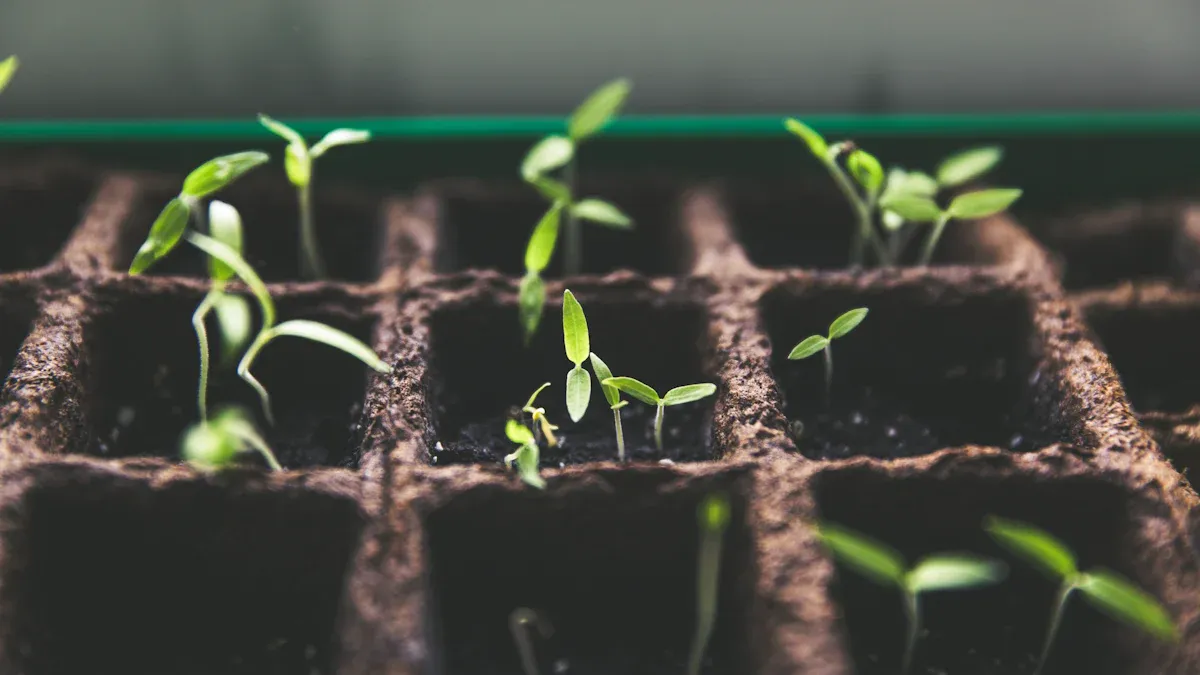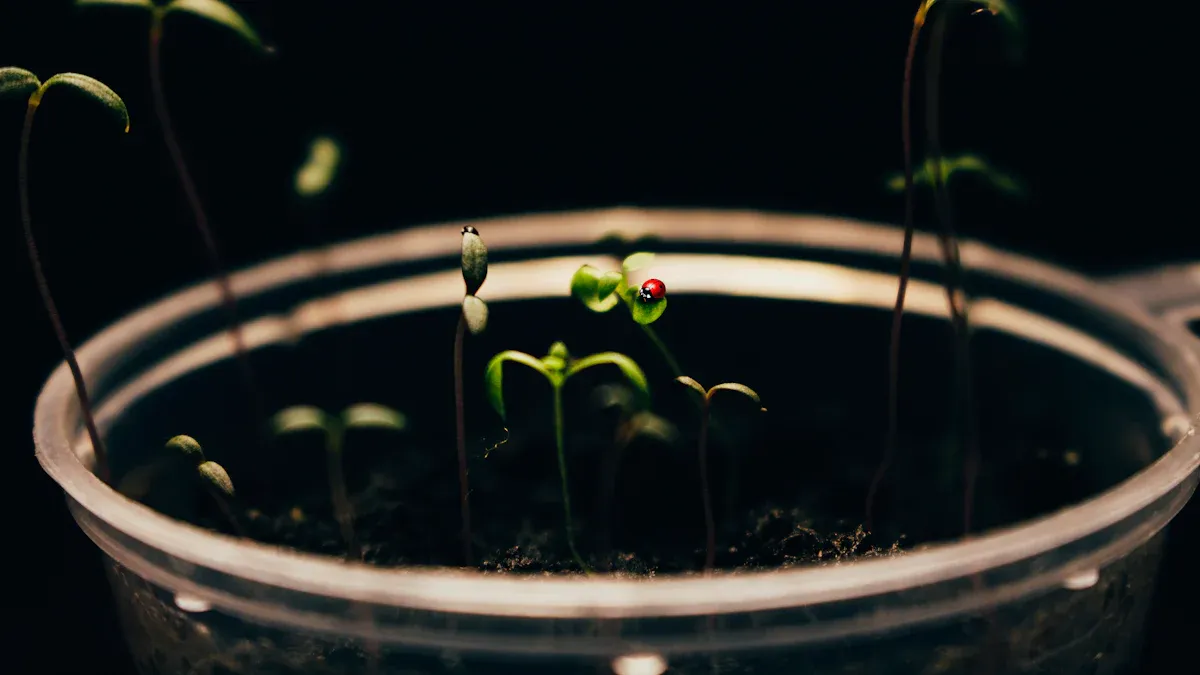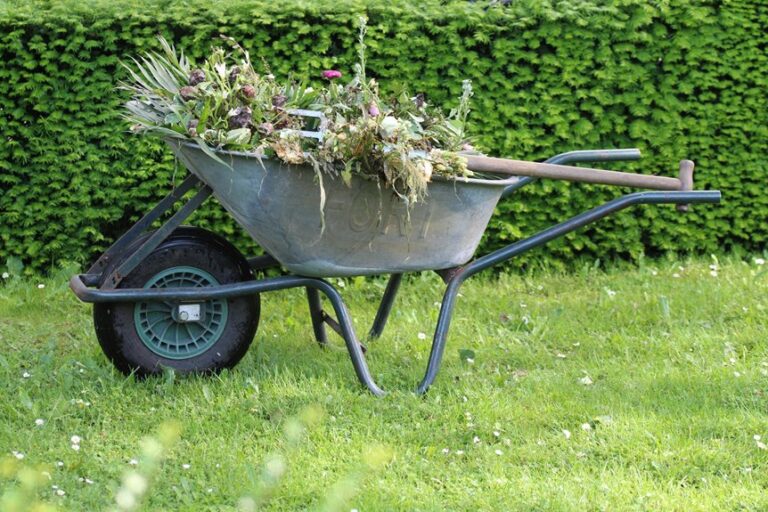
Refrigerating seeds can significantly boost your germination success. This method mimics natural conditions that many seeds encounter in their lifecycle. Understanding seed dormancy is crucial. It explains why some seeds remain inactive until conditions are just right. For instance, several plant species, such as nettles, arbutus unedo, and primula beesiana, require cold stratification for optimal germination. By storing your seeds in a cool environment, you can help them break dormancy and sprout effectively.
Key Takeaways
Refrigerating seeds mimics natural winter conditions, helping them break dormancy and improve germination rates.
Use a damp paper towel or moist sand in a resealable bag to store seeds in the refrigerator for 2 to 4 weeks.
Monitor moisture levels carefully; too much moisture can cause mold, while too little can prevent germination.
Avoid common mistakes like freezing seeds or letting them dry out to ensure successful germination.
Refrigeration not only extends seed lifespan but also saves money by maintaining seed viability for longer periods.
Seed Dormancy

What is Seed Dormancy?
Seed dormancy refers to the state where viable seeds do not germinate even under favorable conditions. This phenomenon is crucial for plant survival, as it allows seeds to wait for the right environmental cues before sprouting. Dormancy ensures that seeds do not germinate too early, which could lead to poor growth or death.
Here are some key points about seed dormancy:
Definition: Seed dormancy is the inability of a viable seed to germinate under suitable conditions.
Timing: Dormancy affects the timing of germination by requiring specific physiological and environmental conditions to be met.
Breaking Dormancy: Factors like moist chilling (cold stratification) and after-ripening are essential for breaking dormancy.
Understanding seed dormancy helps you predict when seeds will germinate and how successful that germination will be.
Factors Influencing Dormancy
Several factors influence seed dormancy, including environmental conditions and genetic makeup. Here are some of the most significant factors:
Temperature: Lower temperatures during seed maturation can increase dormancy depth. Seeds exposed to cold conditions often require similar conditions to germinate.
Moisture: Adequate moisture is vital for breaking dormancy. Seeds need water to initiate the germination process.
Nutrient Availability: Nutrients, particularly nitrate levels, play a role in dormancy. Seeds may remain dormant if nutrients are scarce.
Genetic Factors: The genetic makeup of seeds contributes to their dormancy characteristics. Variability in seed permeability to water is genetically controlled. For example, two quantitative trait loci (QTLs) have been identified that explain significant variation in seed permeability.
Mechanism Type | Description |
|---|---|
Physical Dormancy | Most prevalent in legumes; involves seed coat characteristics that prevent water uptake. |
Physiological Dormancy | Involves hormonal interactions, particularly between abscisic acid (ABA) and gibberellins (GA). |
Seed Coat Characteristics | Hard, pectinaceous outer layer or higher lignin content contributes to impermeability. |
By understanding these factors, you can better manage your seeds and improve your germination rates.
Cold Stratification Benefits

How Cold Temperatures Help Germination
Cold temperatures play a vital role in breaking seed dormancy. When you expose seeds to cold conditions, you mimic the natural winter environment that many seeds experience. This exposure triggers physiological changes within the seeds, preparing them for germination.
For example, a study on Paeonia ostii showed that cold temperatures are essential for breaking seed dormancy and enhancing germination rates. The research indicated that seeds did not germinate under low temperatures alone. They required a specific sequence of warm and cold stratification to facilitate growth. Cold stratification was necessary to break the dormancy of the epicotyl, while warm stratification allowed the radicle to emerge. This highlights the complex interaction between temperature and seed development.
Additionally, cold stratification significantly increases seed germination rates. In tests, nearly 100% germination was observed for lavender seeds when cold stratification was applied before sowing. This demonstrates the effectiveness of the cold stratification method in improving germination rates.
The Role of Moisture in Cold Stratification
Moisture is another critical factor in the cold stratification process. Seeds need the right amount of moisture to activate their metabolic processes. However, too much moisture can lead to seed rot, which can ruin your efforts.
To achieve effective cold moist stratification, follow these steps:
Prepare your medium by folding a paper towel in half and lightly dampening it with water, ensuring it is not soaked.
Place the seeds on the damp paper towel in a single layer.
Seal the paper towel and seeds in a plastic bag, removing excess air.
Label the bag with the seed type.
Refrigerate the bag for 2 to 3 weeks, avoiding excessive moisture to prevent seed rot.
By maintaining the right moisture levels during cold stratification, you can enhance the chances of successful germination. This careful balance between cold temperatures and moisture creates an ideal environment for your seeds to thrive.
Refrigerating Seeds: Practical Steps
Materials Needed
To successfully refrigerate seeds, gather the following materials:
Airtight Containers: Use glass jars with rubber seals or vacuum-sealed bags to protect seeds from air and moisture.
Desiccants: Include silica gel packets or rice to absorb excess moisture and maintain low humidity.
Damp Paper Towels: These will help keep seeds moist during refrigeration.
Plastic Bags or Tupperware: Use these to store the damp paper towels and seeds together.
Labels: Keep track of different seed types for easy identification.
Step-by-Step Refrigeration Process
Follow these steps to ensure maximum viability and germination of your seeds:
Prepare the Seeds: Ensure seeds are properly dried before storage. This prevents mold and contamination.
Moisten the Paper Towel: Place seeds in a damp paper towel and fold it. The towel should be moist but not soaked.
Seal the Seeds: Put the towel in a plastic bag or Tupperware. Ensure it is not sealed tightly to allow for aeration.
Store in the Refrigerator: Place the bag or container in the refrigerator at a temperature between 35°F to 40°F (1.6°C to 4.4°C).
Monitor Moisture: Check the seeds every couple of days to ensure they remain moist. If they begin to sprout, prepare small pots for transplanting.
Label the Seeds: Clearly label each container with the seed type and date of refrigeration.
Duration: Refrigerate seeds for about 2 to 4 weeks, depending on the plant species. This cold stratification period helps break dormancy.
By following these steps, you can effectively refrigerate seeds and enhance their chances of successful germination.
Summary of Benefits and Pitfalls
Advantages of Refrigerating Seeds
Refrigerating seeds offers several advantages that can enhance your gardening success. Here are some key benefits:
Higher Germination Success: Cold stratification mimics natural winter conditions, helping seeds break dormancy and sprout effectively.
Economic Savings: Proper refrigeration can save seeds economically. You can store seeds for longer periods without losing viability.
Maintaining Viability: The primary purpose of seed storage is to keep seeds in a viable state. This ensures they can germinate and produce healthy plants.
Reduced Deterioration: Key factors like oxygen pressure, moisture content, and temperature determine seed deterioration. Refrigeration helps control these factors.
By understanding these advantages, you can appreciate the importance of proper seed storage techniques.
Common Mistakes to Avoid
While refrigerating seeds can boost germination rates, certain mistakes can hinder your success. Here are some common pitfalls to watch out for:
Letting the Substrate Grow Mold: High temperatures above 45°F (7°C) can lead to mold growth, which can infect seeds.
Freezing Your Seeds: Freezing can cause cracks and splits in seeds, damaging plant cells and reducing germination rates.
Letting Seeds Dry in the Fridge: Seeds need to maintain a high moisture level. If they dry out, they may fail to germinate.
Not Reading Seed Packets: Ignoring the instructions on seed packets can lead to poor germination rates and weak plants.
Using the Wrong Soil: Inappropriate soil can inhibit root development, negatively impacting seedlings.
To avoid these mistakes, ensure you follow proper refrigeration techniques and monitor your seeds regularly. This attention to detail will help you achieve consistent seedling emergence and a thriving garden.
Refrigerating seeds offers numerous benefits that can lead to successful germination. This practice mimics natural conditions, helping seeds break dormancy and sprout effectively. Here are some key points to remember:
Refrigerate seeds to extend their lifespan and provide cold stratification.
Use a resealable bag with moist sand or a damp paper towel.
Keep the bag slightly open and refrigerate at around 40°F (4°C).
By following these steps, you can enhance your gardening success. Try refrigerating your seeds and share your experiences with others. Your journey can inspire fellow gardeners to adopt this effective practice!
FAQ
What types of seeds benefit from refrigeration?
Many seeds, especially those from temperate climates, benefit from refrigeration. Examples include perennial flowers, certain vegetables, and native plants. These seeds often require cold stratification to break dormancy and promote healthy growth.
How long should I refrigerate seeds?
Refrigerate seeds for about 2 to 4 weeks. This duration allows seeds to undergo cold stratification, which helps them break dormancy and improves germination rates. Check specific seed packets for tailored recommendations.
Can I freeze seeds instead of refrigerating them?
Freezing seeds is not recommended. Freezing can damage seeds by causing cracks and splits. Instead, refrigerate seeds at temperatures between 35°F to 40°F (1.6°C to 4.4°C) for optimal results.
How do I know if my seeds are still viable?
To test seed viability, place seeds in a damp paper towel and keep them warm. Check for germination within a week or two. If most seeds sprout, they are viable. If not, consider replacing them.
What should I do if my seeds start to sprout in the fridge?
If seeds begin to sprout in the fridge, prepare small pots with soil for transplanting. Carefully transfer the seedlings to the pots, ensuring they receive adequate light and moisture for healthy growth.


